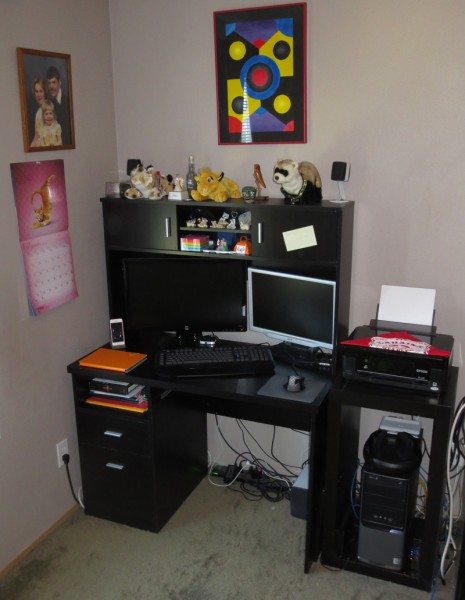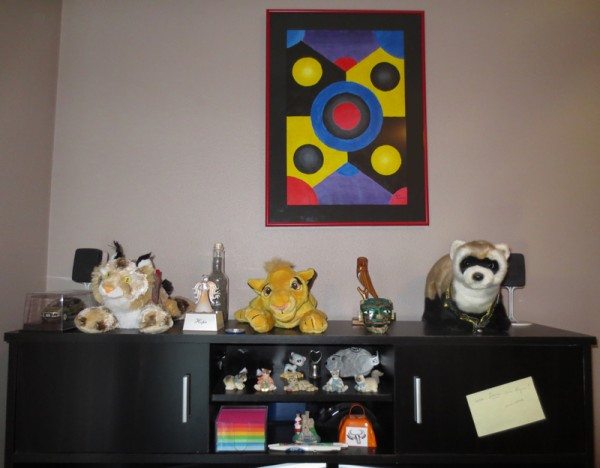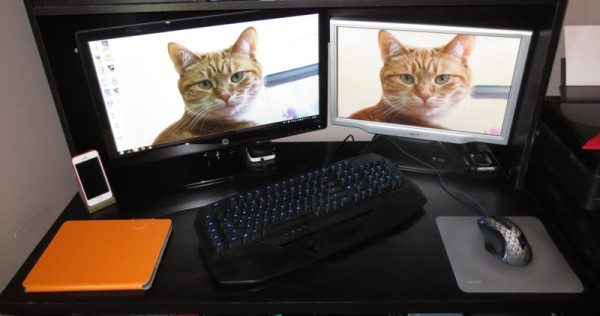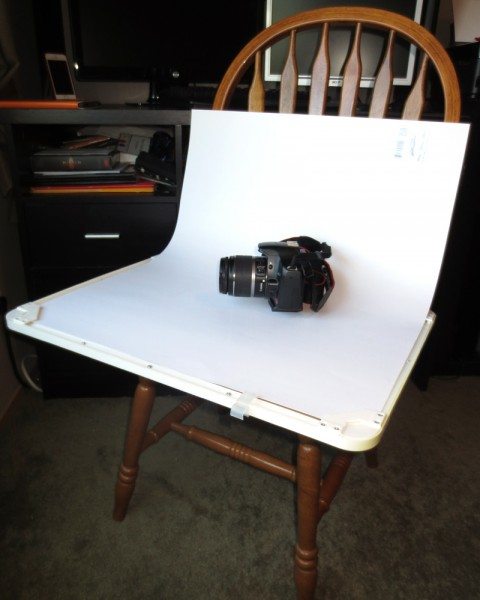
My first computer was given to me in 9th grade, which was a laptop running Windows 98. Before that, we had rented a computer for word processing from a Nebraska agency, which ran Windows 95 and had a dot matrix printer along with it. Being one of the relatively young Gadgeteers, you may laugh at my first taste of computers, but those first two computers got me hooked into gadgets and gaming. Nowadays I try to keep an average computer; not too expensive, but still performs well, which led me to build my own PC to get just what I wanted.
Above is a photo of what my current layout looks like. You can see my home built PC down in my makeshift printer stand (which is a shelving unit from IKEA without the shelves) and my Epson XP-400 printer. The reason I use the IKEA shelving unit for my printer stand is because my husband’s desk, which is the same as my own, is sandwiching it in, so we had to get something very thin but tall enough and with enough ventilation to put my PC in as well. Our router, an ASUS WL-520GU is flashed with tomato (don’t ask me what that is, my husband did it!) and my gaming headset is a cheap Plantronics Gamecom unit from Fry’s.

The hutch part of my desk holds anything special I may have gotten through the years, along with my game CDs (which are inside of the doors, and highly disorganized) some pens, a non-sticky note pad, an extra mouse, pencil sharpener, and the two small speakers hooked up to my PC (the small sub-woofer is at my feet in the first picture). The left stuffed animal is my Peru State College mascot (a bobcat), the green face is a souvenir gift from my parents from the Yucatan peninsula, and the ferret is in memory of the ferret I had as a teenager, to name a few of the special items.

Here is my main work area. All but a few reviews I’ve done have been typed up here. I have a dual monitor setup, the right is normally my email monitor, while the left is for everything else. I have a little phone stand I got from the Ford conference I attended earlier this year which is made from their 3D printers and my iPad normally stays somewhere on my desk as well. Under my left monitor is my volume control, with my headset currently plugged in. Under the right monitor is my Gear Head USB hub which is a cheap but very reliable hub. My keyboard is the ROCCAT Ryos MK Glow mechanical keyboard, and my mouse is the Sharkoon Drakonia Black gaming mouse, both review items.

Now you can laugh at my incredibly cheap yet efficient photo studio. I live in a small condo, with horrible lighting, and nowhere to put a dedicated staging area. My solution was to buy a piece of thick white paper, flexible yet strong, which happened to fit perfectly inside the back of a dry-erase board we had lying around. Stick it on a chair, and it provides a great staging area. To combat the lack of light, I take my photos towards an open window, which gives the pictures, in my opinion, a more natural look than using the flash.

I normally take pictures with my Canon EOS Rebel XSi, but for this shot, I used my Canon PowerShot ELPH110HS. The pictures sometimes have a little shadowing on the bottom, which can normally be fixed in Photoshop easily enough.
That is my Gadgeteer workstation! I hope that by the next time we have another round of “Show us your desk” that I will be in a house with a much roomier computer room. In the meantime, I just have to make the best out of what I have!



Gadgeteer Comment Policy - Please read before commenting
In all of the desk articles, each and every one features a rat’s nest of cables on the floor as do I. In the age of everything wifi, why on earth can’t manufacturers make all the pieces wifi? The monitor, the speakers, the subwoofers,the back up hard drive, and on and on. Its the 21st century for god’s sake, why must we all have these rat’s nests?
Almost all of the items you mentioned can be found in wireless versions – they cost more, and have significant downsides, but they exist.
A wired connection is cheap and reliable. It’s only real downside is that you can’t move items around very much. Wireless connections are more expensive, and less reliable – and they get in each other’s way. Their main advantage is that you aren’t tied to location, just distance.
So, the short reason for why we have wired connections is that *it’s the better solution*. I can set up a desk so that there isn’t a rat’s nest of cables if I spend a few extra minutes, but the downsides of a wireless connection are permanent and pervasive.
I also wonder what kind of impact your internet connection would take if you had a house full of wifi devices.
My cables are all relatively neatly arranged in my office. I have hooks under the desk on the back wall that I run the wires. Most of them are hidden by the drawer.
In our condo, we have 16 things connected to our home WiFi – 3 iPads, 3 iPhones, 3 laptops, a desktop computer, printer, Hue lights hub, 2 WeMo switches, and two Apple TVs. Granted, not everything is connected and in operation all at the same time, but we routinely see speeds of 25-30 mbps when we do speed tests on our iPads and computers. (We pay for 30 mbps.)
And I have a nest of cables under my desk, but they are all power cables. My monitor is connected to my Mac mini by a cable, but everything else in my office is connected via WiFi instead of cables.
Most of the cables under my desk are power cables: 2 monitors, 1 speakers, 1 powered external HD, and 1 computer.
The only things that I have that can be turned wireless are my headphones (but I love my old ones), my keyboard, and my mouse. Now that large rats nest on the right side of my computer.. that’s my husband’s stuff. 😉 His makes mine look so nice and organized!
@Janet, 30 mbps is glacially slow when you are talking about hard drives or monitors, and Ethernet (which all your wireless devices are running) does very well at giving one user all the bandwidth when it’s the only user who wants it. Most of your devices will need less than 1 Mbps on a regular basis, so the speed tests were likely uninhibited by interference – which doesn’t mean interference didn’t exist, just that it was *handled*. And doing that handling takes processing power and energy. (Try doing the speed tests from two machines at once – I’d bet it’d fall over badly.)
Wired doesn’t have that issue. The connection is much simpler, and there is much less chance for problems. (And the problems can be corrected with cheaper hardware: a few cents worth of tinfoil in the wire vs. a few dollars for a signal processing chip.)
The interference problem grows with the speed of the connection, as well. (And don’t think that only computer devices are part of the issue: They aren’t. Anything can generate wireless interference. Famously _microwave ovens_ operate in the same band as older wifi equipment.)
So, for slow speeds, yes it can be handled at reasonable costs. It doesn’t change that for the common desktop cases wired is cheaper and more trouble-free.